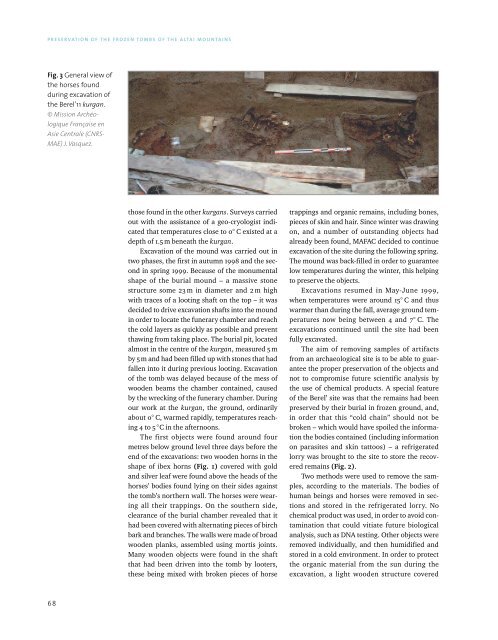Scythian Culture - Preservation of The Frozen Tombs of The Altai Mountains (UNESCO)
You also want an ePaper? Increase the reach of your titles
YUMPU automatically turns print PDFs into web optimized ePapers that Google loves.
PRESERVATION OF THE FROZEN TOMBS OF THE ALTAI MOUNTAINS<br />
Fig. 3 General view <strong>of</strong><br />
the horses found<br />
during excavation <strong>of</strong><br />
the Berel’11 kurgan.<br />
© Mission Archéologique<br />
Française en<br />
Asie Centrale (CNRS-<br />
MAE) J. Vasquez.<br />
those found in the other kurgans. Surveys carried<br />
out with the assistance <strong>of</strong> a geo-cryologist indicated<br />
that temperatures close to 0° C existed at a<br />
depth <strong>of</strong> 1.5 m beneath the kurgan.<br />
Excavation <strong>of</strong> the mound was carried out in<br />
two phases, the first in autumn 1998 and the second<br />
in spring 1999. Because <strong>of</strong> the monumental<br />
shape <strong>of</strong> the burial mound – a massive stone<br />
structure some 23 m in diameter and 2 m high<br />
with traces <strong>of</strong> a looting shaft on the top – it was<br />
decided to drive excavation shafts into the mound<br />
in order to locate the funerary chamber and reach<br />
the cold layers as quickly as possible and prevent<br />
thawing from taking place. <strong>The</strong> burial pit, located<br />
almost in the centre <strong>of</strong> the kurgan, measured 5 m<br />
by 5 m and had been filled up with stones that had<br />
fallen into it during previous looting. Excavation<br />
<strong>of</strong> the tomb was delayed because <strong>of</strong> the mess <strong>of</strong><br />
wooden beams the chamber contained, caused<br />
by the wrecking <strong>of</strong> the funerary chamber. During<br />
our work at the kurgan, the ground, ordinarily<br />
about 0° C, warmed rapidly, temperatures reaching<br />
4 to 5 °C in the afternoons.<br />
<strong>The</strong> first objects were found around four<br />
metres below ground level three days before the<br />
end <strong>of</strong> the excavations: two wooden horns in the<br />
shape <strong>of</strong> ibex horns (Fig. 1) covered with gold<br />
and silver leaf were found above the heads <strong>of</strong> the<br />
horses’ bodies found lying on their sides against<br />
the tomb’s northern wall. <strong>The</strong> horses were wearing<br />
all their trappings. On the southern side,<br />
clearance <strong>of</strong> the burial chamber revealed that it<br />
had been covered with alternating pieces <strong>of</strong> birch<br />
bark and branches. <strong>The</strong> walls were made <strong>of</strong> broad<br />
wooden planks, assembled using mortis joints.<br />
Many wooden objects were found in the shaft<br />
that had been driven into the tomb by looters,<br />
these being mixed with broken pieces <strong>of</strong> horse<br />
trappings and organic remains, including bones,<br />
pieces <strong>of</strong> skin and hair. Since winter was drawing<br />
on, and a number <strong>of</strong> outstanding objects had<br />
already been found, MAFAC decided to continue<br />
excavation <strong>of</strong> the site during the following spring.<br />
<strong>The</strong> mound was back-filled in order to guarantee<br />
low temperatures during the winter, this helping<br />
to preserve the objects.<br />
Excavations resumed in May-June 1999,<br />
when temperatures were around 15° C and thus<br />
warmer than during the fall, average ground temperatures<br />
now being between 4 and 7° C. <strong>The</strong><br />
excavations continued until the site had been<br />
fully excavated.<br />
<strong>The</strong> aim <strong>of</strong> removing samples <strong>of</strong> artifacts<br />
from an archaeological site is to be able to guarantee<br />
the proper preservation <strong>of</strong> the objects and<br />
not to compromise future scientific analysis by<br />
the use <strong>of</strong> chemical products. A special feature<br />
<strong>of</strong> the Berel’ site was that the remains had been<br />
preserved by their burial in frozen ground, and,<br />
in order that this “cold chain” should not be<br />
broken – which would have spoiled the information<br />
the bodies contained (including information<br />
on parasites and skin tattoos) – a refrigerated<br />
lorry was brought to the site to store the recovered<br />
remains (Fig. 2).<br />
Two methods were used to remove the samples,<br />
according to the materials. <strong>The</strong> bodies <strong>of</strong><br />
human beings and horses were removed in sections<br />
and stored in the refrigerated lorry. No<br />
chemical product was used, in order to avoid contamination<br />
that could vitiate future biological<br />
analysis, such as DNA testing. Other objects were<br />
removed individually, and then humidified and<br />
stored in a cold environment. In order to protect<br />
the organic material from the sun during the<br />
excavation, a light wooden structure covered<br />
68
















